Racial-Ethnic Residential Clustering and Early COVID-19 Vaccine Allocations in Five Urban Texas Counties
- PMID: 35164599
- PMCID: PMC9716049
- DOI: 10.1177/00221465221074915
Racial-Ethnic Residential Clustering and Early COVID-19 Vaccine Allocations in Five Urban Texas Counties
Abstract
Previous research has indicated that racial-ethnic minority communities lack a wide variety of health-related organizations. We examine how this relates to the early COVID-19 vaccine rollout. In a series of spatial error and linear growth models, we analyze how racial-ethnic residential segregation is associated with the distribution of vaccine sites and vaccine doses across ZIP codes in the five largest urban counties in Texas. We find that Black and Latino clustered ZIP codes are less likely to have vaccine distribution sites and that this disparity is partially explained by the lack of hospitals and physicians' offices in these areas. Moreover, Black clustering is also negatively related to the number of allocated vaccine doses, and again, this is largely explained by the unequal distribution of health care resources. These results suggest that extant disparities in service provision are key to understanding racial-ethnic inequality in an acute crisis like the COVID-19 pandemic.
Keywords: COVID-19; health care; race-ethnicity; residential segregation; vaccines.
Figures
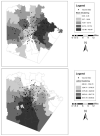
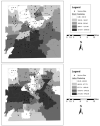
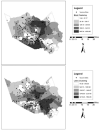
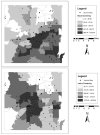
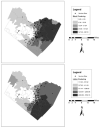
Similar articles
-
Quantifying inequities in COVID-19 vaccine distribution over time by social vulnerability, race and ethnicity, and location: A population-level analysis in St. Louis and Kansas City, Missouri.PLoS Med. 2022 Aug 26;19(8):e1004048. doi: 10.1371/journal.pmed.1004048. eCollection 2022 Aug. PLoS Med. 2022. PMID: 36026527 Free PMC article.
-
Inequities in COVID-19 vaccine and booster coverage across Massachusetts ZIP codes after the emergence of Omicron: A population-based cross-sectional study.PLoS Med. 2023 Jan 31;20(1):e1004167. doi: 10.1371/journal.pmed.1004167. eCollection 2023 Jan. PLoS Med. 2023. PMID: 36719864 Free PMC article.
-
Analysis of Residential Segregation and Racial and Ethnic Disparities in Severe Maternal Morbidity Before and During the COVID-19 Pandemic.JAMA Netw Open. 2022 Oct 3;5(10):e2237711. doi: 10.1001/jamanetworkopen.2022.37711. JAMA Netw Open. 2022. PMID: 36264572 Free PMC article.
-
Racial residential segregation and COVID-19 vaccine uptake: an analysis of Georgia USA county-level data.BMC Public Health. 2023 Jul 20;23(1):1392. doi: 10.1186/s12889-023-16235-0. BMC Public Health. 2023. PMID: 37468835 Free PMC article.
-
Associations of Race/Ethnicity and Food Insecurity With COVID-19 Infection Rates Across US Counties.JAMA Netw Open. 2021 Jun 1;4(6):e2112852. doi: 10.1001/jamanetworkopen.2021.12852. JAMA Netw Open. 2021. PMID: 34100936 Free PMC article.
Cited by
-
Inequality in the distribution of Covid-19 vaccine: a systematic review.Int J Equity Health. 2022 Aug 30;21(1):122. doi: 10.1186/s12939-022-01729-x. Int J Equity Health. 2022. PMID: 36042485 Free PMC article.
-
Racial concentration and dynamics of COVID-19 vaccination in the United States.SSM Popul Health. 2022 Sep;19:101198. doi: 10.1016/j.ssmph.2022.101198. Epub 2022 Aug 18. SSM Popul Health. 2022. PMID: 35996681 Free PMC article.
-
Spatial and Ethno-national Health Inequalities: Health and Mortality Gaps between Palestinians and Jews in Israel.J Health Soc Behav. 2025 Jun;66(2):182-196. doi: 10.1177/00221465241283455. Epub 2024 Oct 22. J Health Soc Behav. 2025. PMID: 39435571 Free PMC article.
-
Residential Segregation and County-Level COVID-19 Booster Coverage in the Deep South: Surveillance Report and Ecological Study.JMIR Public Health Surveill. 2023 Dec 5;9:e44257. doi: 10.2196/44257. JMIR Public Health Surveill. 2023. PMID: 38051568 Free PMC article.
-
A Bibliometric Analysis on Research Regarding Residential Segregation and Health Based on CiteSpace.Int J Environ Res Public Health. 2022 Aug 15;19(16):10069. doi: 10.3390/ijerph191610069. Int J Environ Res Public Health. 2022. PMID: 36011701 Free PMC article. Review.
References
-
- Acevedo-Garcia Dolores. 2000. “Residential Segregation and the Epidemiology of Infectious Diseases.” Social Science & Medicine 51(8):1143–61. - PubMed
-
- Allard Scott W.2009. Out of Reach: Place, Poverty, and the New American Welfare State. New Haven, CT: Yale University Press.
-
- Anderson Kathryn Freeman. 2017. “Racial Residential Segregation and the Distribution of Health-Related Organizations in Urban Neighborhoods.” Social Problems 64(2):256–76.
MeSH terms
Substances
LinkOut - more resources
Full Text Sources
Medical

